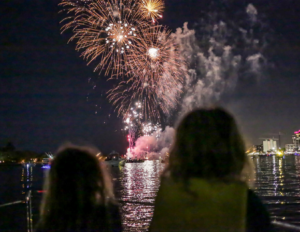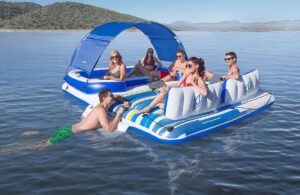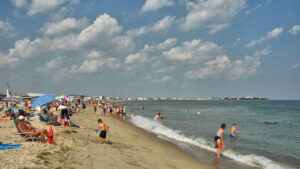The historic Chesapeake Bay hotels are a time traveler’s dream. For more than 300 years, luxurious lodgings have risen along the shoreline and now offer today’s guests a glimpse into America’s past. Behind modern amenities like flat-screen TVs and high-speed internet are walls that withstood the test of time from colonial rebellions to industrial revolutions.
These remarkable hotels have harbored sailors who were shipped off to maritime battles, celebrated marriages of society’s elite and showed European royalty high times on this side of the pond. You find them in unlikely places — quaint seaside villages, rolling farmlands and urban areas nestled among steely skyscrapers. Several boast of resident ghosts. All of them have stories to tell.
As you cruise around the Bay this summer, take a journey back in time by adding vintage charm to your accommodations in the region’s historic hotels.
Colonial Dames with Revolutionary Style
During the early 1700s, the Chesapeake Bay was a vibrant hub of Colonial America, where fortunes were made and homes were built to accommodate the lifestyles of a growing upper class. British monarchs doled out thousands of acres of fertile soil in land grants to friends and farmers who produced tobacco, grain, livestock and lumber. With slaves and indentured servants as cheap labor, the Bay’s landed gentry filled their pockets by selling raw materials to Europe. And the booming trade industry bolstered a class of wealthy sea merchants who raked in riches by shipping goods across the Atlantic.
Before long, grand estates and elegant mansions graced the Bay’s shores. Today, many of those homes have become hotels that invite guests to sleep in beds where tobacco plantation owners once pulled quilts over their shoulders or gaze through windows where sea captain’s wives watched for their husband’s ship to return.
The Inn at Warner Hall in Gloucester, Va., offers a splendid retro experience. The plantation was established in 1642 by Augustine Warner who received a land grant from England’s queen. His descendents include George Washington and Robert E. Lee. The restored Colonial Revival mansion rests on 38 gorgeous acres near the Severn River not far from Williamsburg and Yorktown. Centuries- old trees, plush gardens and green pastures surround refurbished brick stables, smokehouse, dairy farm and family cemetery. Rooms furnished with period pieces overlook a serene riverfront view.
To witness the life of a prosperous merchant, head to the Robert Morris Inn at Oxford, Md. Its thick timber beams, red brick and paneled walls, and slate floors are a testament to fine 18th-century craftsmanship. The formal dining room features stunning tapestries, window valances and chandeliers. Above the fireplace in the tavern hangs the family coat of arms for Robert Morris, a sea-trade industry titan whose son is known as the Financier of the American Revolution. The younger Morris used his wealth from the shipping biz to leverage capital and provisions for the Continental Army, including $10,000 of his own coin to aid soldiers at the Battle of Trenton.
George Washington often visited Morris’ Oxford home — when he wasn’t scampering around the East Coast stirring up trouble for the King of England. Our first president and his band of American insurgents were notorious for gathering in Chesapeake pubs and inns to lay the groundwork for our new nation.
If you want to contemplate the Constitution or just enjoy lavish lodgings where our founding fathers conspired against the British Crown, visit the Historic Inns of Annapolis. Three beautiful buildings dating back to the mid-1700s comprise the location that overlooks Maryland’s capital and lively port. Each room shares a story of famous guests including statesmen, governors, Revolutionary War heroes and signers of the Declaration of Independence. Recent renovations discretely integrate modern amenities into the historic ambience.
From Social Turmoil to Seaside Heyday
The 1800s were a time of great change along the Chesapeake, as the century rolled in with back-to-back military conflicts and ended in an era of economic growth. During the War of 1812, America’s fledgling Navy wrestled back control of the Atlantic seaboard from the British and cemented a strong maritime tradition in the Bay. Decades later, divided allegiances to the North and South tore the region apart during the Civil War.
Despite these social upheavals, the Bay flourished. Ports buzzed with commerce, shipbuilding boomed, and steamboats carried passengers and cargo from cities to seaside towns creating an energetic pulse of expansion. Once-isolated towns finally gained access to urban culture and architectural trends. Bay residents could order from or travel to Boston, New York or Philadelphia for fabrics, furnishing and design ideas that gave antebellum plantation houses a dose of Victorian pizzazz.
Few Chesapeake Bay hotels pay higher homage to the Bay’s maritime legacy than the Inn at Perry Cabin in St. Michaels, Md. The lodging along the Miles River was built in 1816 by Samuel Hambleton, a War of 1812 veteran and aide-de-camp to Commodore Oliver Hazard Perry. As a tribute to his commander’s victorious campaign against the British in Lake Erie, Hambleton designed the inn to look like the cabin on Perry’s flagship U.S.S. Niagara. Today, the luxury resort proudly carries Perry’s name and encourages guests to join on-site sailing courses and relish the vintage nautical décor.
Also on Maryland’s Eastern Shore, just a quick jaunt from the Bay Bridge, is Kent Manor, which epitomizes the evolution of a rural estate elevated to Victorian elegance. The farmhouse was built in 1820. In 1843, Alexander Thompson inherited the place and erected an addition with Italian marble fireplace mantels and other stylish features. A.T. was a man of the times — rich, flamboyant, cigar smoking and fond of women and his prized white horse. To this day, nearby Thompson Creek beares his name, and some guests swear to smelling his tobacco fumes in nonsmoking rooms and seeing his spirit gallop around the grounds on a pallid steed.
Industrial Strength Glitz & Glamour
When the 20th century came roaring in, the Chesapeake region was poised and ready for action. Manufacturing plants from Baltimore to Norfolk were cranking out everything from tin cans and sugar cubes to steel beams that supported U.S. bridges, skyscrapers and military necessities for waging world wars.
Chesapeake oysters were an international rage, and Prohibition couldn’t halt the flow of the Bay’s popular brews and libations. Baltimore’s industrial barons were ranked alongside the Rockefellers and Vanderbilts. Regional architecture reflected the bawdiness of the day, and hotels achieved new heights in grandeur.
Wharfs were rowdy places, and saloons and brothels were frequented by sailors and immigrants with paychecks burning holes in their pockets. The Admiral Fell Inn, now a lovely hotel in Baltimore’s Fells Point neighborhood, was built to solve some of those social quandaries. In 1900, Port Mission opened a Christian boarding house and recreation center named The Anchorage. After a rigorous delousing, sailors could enjoy a safe night’s sleep inside. The YMCA took over in 1929, expanding the place to 105 rooms, but the lodgings were so small that guests nicknamed it the Doghouse. In 1955, a vinegar factory occupied the space, but it closed in the 1970s. Fortunately in 1996, the location was purchased and turned into a boutique inn with vintage décor.
Baltimore’s upper-crust visitors who were unscathed by the Depression required much swankier accommodations. Built in 1929, the Lord Baltimore Hotel is 23 stories high, holds 440 rooms and boasts 20,000 square feet of ballroom. Famed as the tallest hotel in Maryland at that time, the grand dame remains the preferred location for society events and debutant balls. Its stunning art deco lobby is adorned by elegant columns and brass accents.
The Bay’s southern waters also had its share of opulence, but the most glamorous destination was The Cavalier in Virginia Beach. Construction began in 1926 and was completed in 13 months with manicured golf courses, an indoor pool and an elegant building designed to attract A-list stars. Limousines were stationed at steamer ship and railroad stations, and the hotel office had a photographer and stockbroker with a New York Stock Exchange ticker tape. Big band notables such as Benny Goodman, Cab Calloway and Glenn Miller captivated guests at the Beach Club. An impressive guest roster included F. Scott Fitzgerald, Frank Sinatra, Judy Garland, Elizabeth Taylor, Bing Crosby and presidents from FDR to JFK. Unfortunately in 1942 Uncle Sam was a party pooper and claimed the hotel for use as a radar training station. It reopened in 1976 and underwent extensive renovations in 2014, returning the hotel to its former glory with an on-site distillery brewing top-shelf bourbon, rye whiskey and vodka.
HISTORIC CHESAPEAKE BAY HOTELS
1. Inn at Warner Hall
Gloucester, Va.
2. Robert Morris Inn
Oxford, Md.
3. Historic Inns of Annapolis
4. Inn at Perry Cabin
5. Kent Manor
Stevensville, Md.
6. Admiral Fell Inn
7. Lord Baltimore Hotel
Baltimore, Md.
8. The Cavalier
Virginia Beach, Va.




